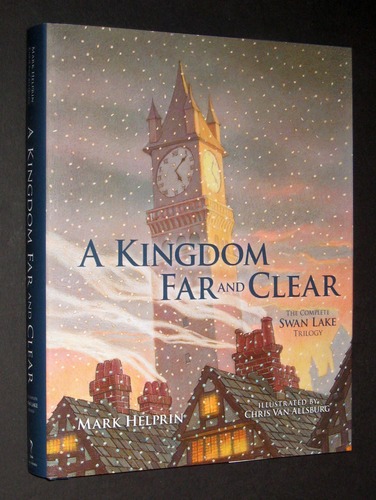 Armed with a gift certificate to the greatest bookstore I know, I browsed the shelves with a light heart, eager to take a risk to purchase something both worthwhile and unknown. A difficult task. The Swan Lake Trilogy beckoned to me in the children's books section (on sale, and it's always a good place for gifts for my godchildren). I picked it up because I'd read the author's name somewhere briefly and was intrigued, though I would've had little to say if anyone had asked me who he was or what he wrote. The heft of the book, its creamy textured pages and startlingly luminous illustrations demanded further investigation. I opened at random and came across this passage:
Armed with a gift certificate to the greatest bookstore I know, I browsed the shelves with a light heart, eager to take a risk to purchase something both worthwhile and unknown. A difficult task. The Swan Lake Trilogy beckoned to me in the children's books section (on sale, and it's always a good place for gifts for my godchildren). I picked it up because I'd read the author's name somewhere briefly and was intrigued, though I would've had little to say if anyone had asked me who he was or what he wrote. The heft of the book, its creamy textured pages and startlingly luminous illustrations demanded further investigation. I opened at random and came across this passage:He had no desire to kill animals. This was owing not so much to compassion as to respect, for not even memory can conspire to make a smoother line than the track of a bird wheeling silently in the sunshine over blue water. And when deer step gingerly in the heather, their precision of motion is art, and that is not to mention the perfect rocketry of their escapes. Were they to go faster, the result would not be so pleasing, and were they to go slower, they would not appear to be nobly disciplining themselves against flight (p. 49).My first reaction, after the initial exhilaration over such verbiage, was that Helprin pays very close attention to things. I was hooked.
I made my way through the book over the course of a month or so, reading before bed. The initial sense that this was not a book for children, or even for adolescents, was confirmed throughout my reading, and I would be hard pressed to argue what its intended audience might be. I suspect that, in the words of CS Lewis, Helprin found that the medium of a fairy tale best suited the tone of whatever it was he saw in his mind's eye, regardless of whether his readers were children. That the vocabulary and tone can at times overwhelm the narrative is a defect only in the sense that it causes Helprin to strike a discordant note here and there, like an exuberant prodigy improvising on the piano.
The trilogy follows the career of a girl banished from her royal inheritance by the intrigues of a usurper, in the first person and then through the perspective of those who accompany her. I found the plot to be tight, with few wasted excursions into descriptive whimsy (though it is here that his prose can be most delightful). He builds to climaxes that are surprising without being arbitrary in their unexpectedness, and knows when a chapter is over.
Van Allsburg's illustrations are full of grandeur and depth, capturing both climactic and simple moments with a remarkable eye for twilight. Before reading the book itself, I took a couple young boys age 3 and 6 through the plates, and both were captivated by the dozens of scenes lifted from the story. We guessed at what they could mean, and found ample material for imaginative prequels in the bright color and elegant forms they portrayed.
A great book? A classic? No. But a delightful find on a winter's day in Wichita, unanticipated and simple? Most definitely!

No comments:
Post a Comment